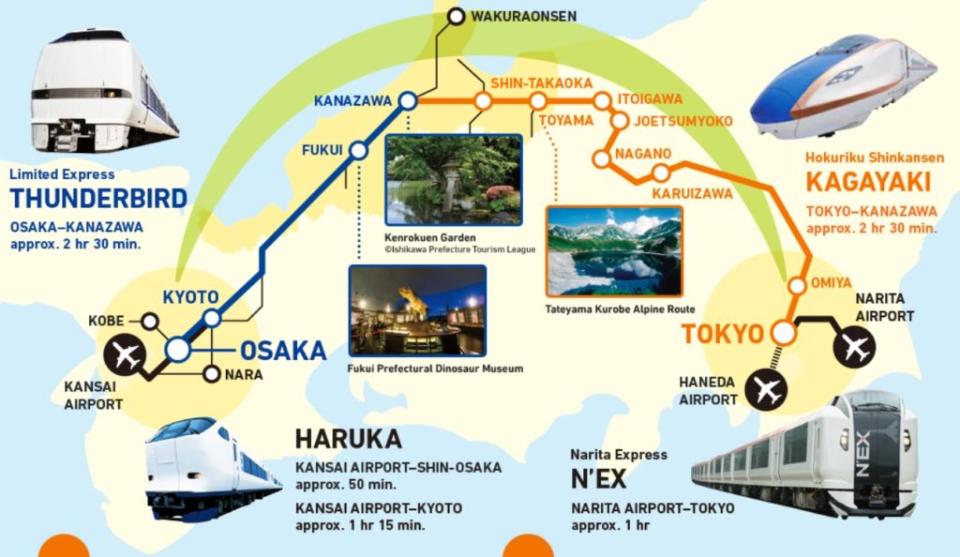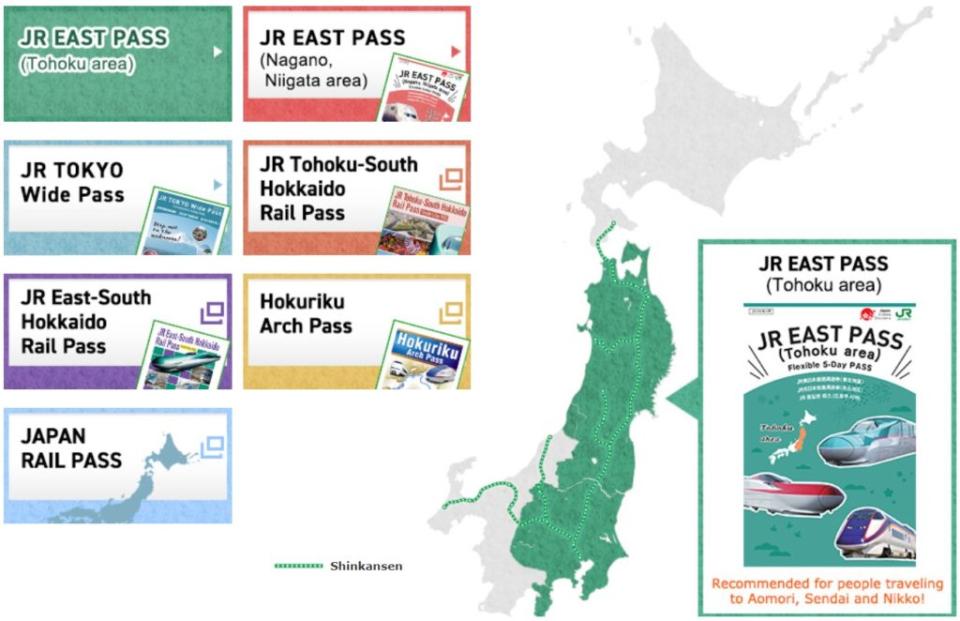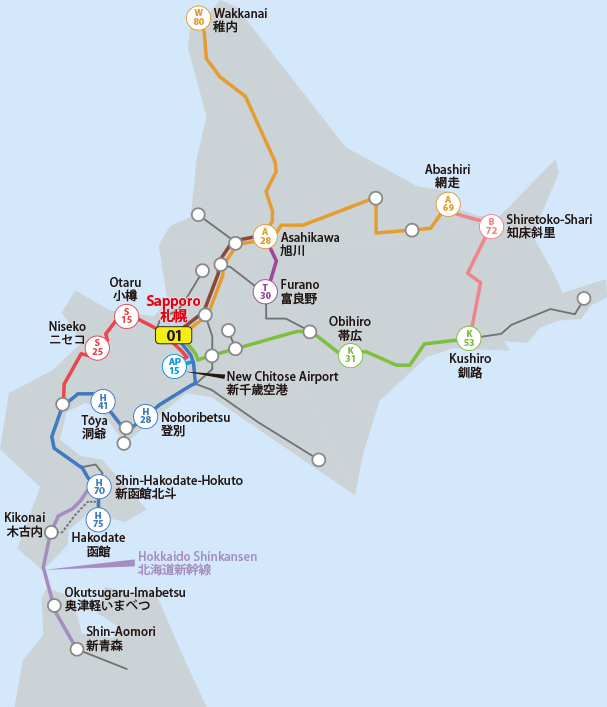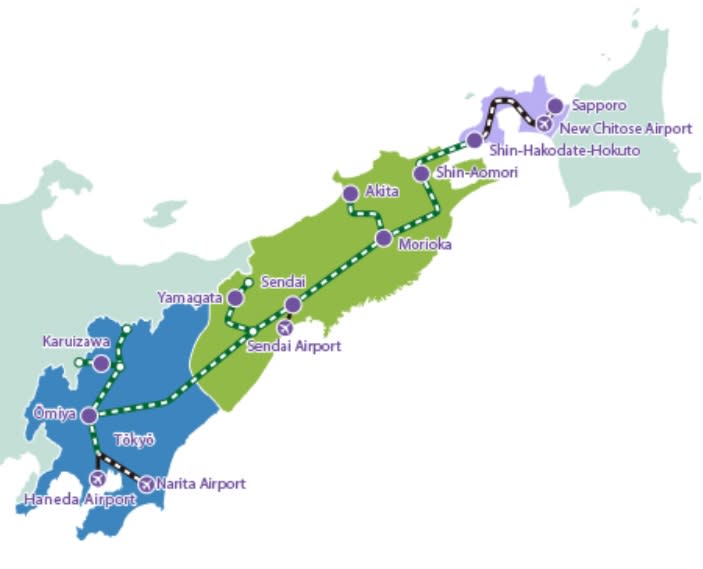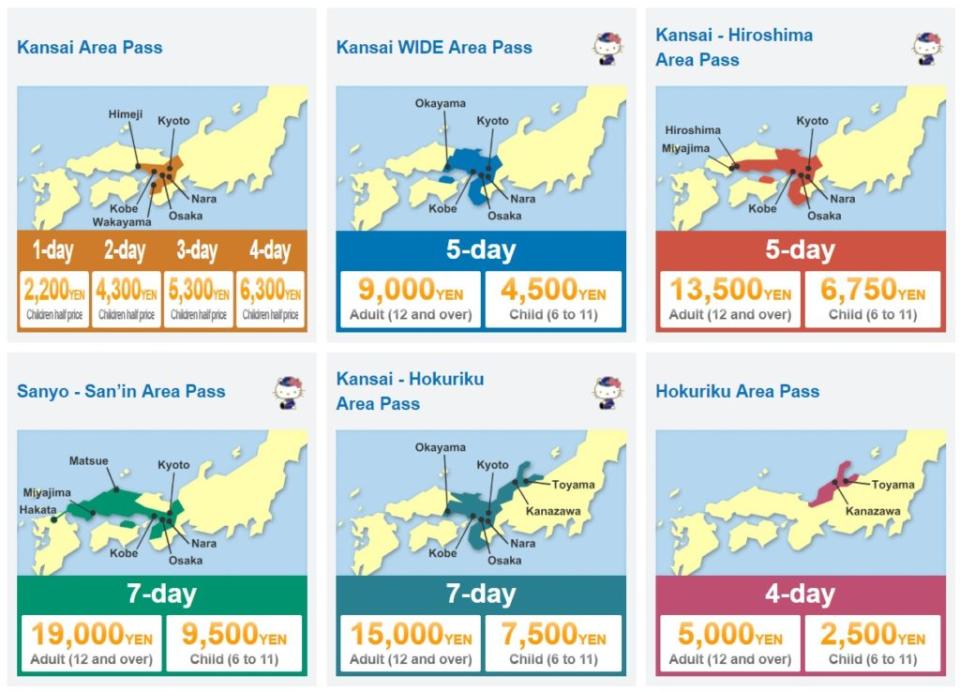JR Pass Singapore (2018) – Ultimate Guide to Japan Rail Pass Types & Prices
There are some Singaporeans who travel to Japan so much that the names of obscure towns roll off their tongues like nobody’s business. For the rest of us, travelling around Japan is and will always remain a mystery.
Booking flights from Singapore to Japan is easy enough, but once you’re there, you’ll need to figure out the intricacies of the Japan rail and public transport systems (yes, plural). And more importantly, you need to calculate whether it’s worthwhile to buy a JR Pass in Singapore before you fly.
What exactly is JR Pass, you ask? This is short for the Japan Rail Pass, basically an unlimited travel pass that lets tourists take Japan Railways trains for a certain number of days. You don’t need it for travelling within the city, but if you’re travelling across several prefectures, it might be more cost-effective than buying train tickets a la carte.
To make things confusing, on top of the nationwide Japan Rail Pass, there are also many cheaper regional JR Passes e.g. JR Hokkaido Pass, JR Kansai Pass and JR Kyushu Pass.
So which JR Pass should you get, and how much does it cost? Here’s a guide to help you make sense of the options available.
Contents
Overview of Japan Rail Pass prices
Here’s an overview of the most popular tourist JR Passes available in Japan. (Don’t worry if it makes no sense just yet – I’ll cover them systematically later.)
Japan Rail Pass | Areas covered | Validity | JR Pass price |
Japan Rail Pass (Ordinary) | All of Japan | 7 / 14 / 21 days | ¥29,110 / ¥46,390 / ¥59,350 |
Japan Rail Pass (Green) | All of Japan | 7 / 14 / 21 days | ¥38,880 / ¥62,950 / ¥81,870 |
JR Hokuriku Arch Pass | Tokyo to Osaka + Kyoto | 7 days | ¥24,000 |
JR Tokyo Wide Pass | Greater Tokyo | 3 days | ¥10,000 |
JR East Pass (Nagano, Niigata) | Tokyo + East Japan | 5 days | ¥17,000 |
JR East Pass (Tohoku) | Tokyo + East Japan | 5 days | ¥19,000 |
JR East-South Hokkaido Pass | Tokyo + East Japan + South Hokkaido | 6 days | ¥26,000 |
JR Hokkaido Rail Pass | Hokkaido | 3 to 7 days | ¥16,500 to ¥24,000 |
JR Kansai Pass | Kansai (Osaka + Kyoto) | 1 to 4 days | ¥2,200 to ¥6,300 |
JR Kansai Wide Pass | Greater Kansai | 5 days | ¥9,000 |
JR Takayama-Hokuriku Pass | Kansai + Hokuriku + Nagoya | 5 days | ¥14,000 |
JR Kansai-Hokuriku Pass | Kansai + Hokuriku region | 7 days | ¥15,000 |
JR Sanyo-San’in Pass | Kansai + Fukuoka | 7 days | ¥19,000 |
JR Kyushu Pass | Kyushu island | 3 / 5 days | ¥15,000 / ¥18,000 |
Prices are for adult passes purchased outside of Japan. There’s also a 50% discount for children aged 6 to 11 (kids up to age 5 travel for free).
Not only is it 10% to 15% cheaper to buy it outside of Japan, it’s also actually more readily available. (There’s not much info on where exactly in Japan you can buy the JR Pass.) You can buy them easily in Singapore; the last section will cover where to buy JR Passes before you fly.
As you can see, there are a TON of regional JR Passes…. and this is after I omitted the ones that not worth considering because they don’t let you travel to and from major cities.
However, there’s a simple way to break it all down. I’ve organised them according to these common travel needs:
Japan Rail Pass – the JR Pass that covers all of Japan
The original JR Pass that most Singaporeans would be familiar with is the Japan Rail Pass. This covers practically all of Japan, which is connected by an extensive JR (Japan Railway) network.
There are two versions of the JR Pass: Ordinary and Green. The former is cheaper, but it only lets you board Ordinary or coach class. If you’re travelling during non-peak periods, an Ordinary pass will suffice. As anyone who’s taken the train in Japan can tell you, even coach class is super clean and comfortable.
Spending more on Green gives you access to Green or superior class, which is found on long-distance trains. If you’re travelling during peak travel season e.g. cherry blossom season, it might be worthwhile to splurge on a Green JR Pass. During these periods, coach class is packed to the brim. It’ll be easier to get seats in the more expensive Green cars.
After deciding on which class you want, the next step is to decide on the number of days: 7, 14 or 21 consecutive days. You can specify the exact date on which you want to activate your pass.
Putting it all together, here’s a table to show you how much each variant costs, with approx. cost in SGD alongside:
Validity | JR Pass (Ordinary) | JR Pass (Green) |
7 days | ¥29,110 (S$358.65) | ¥38,880 (S$479.02) |
14 days | ¥46,390 (S$571.54) | ¥62,950 (S$775.57) |
21 days | ¥59,350 (S$731.22) | ¥81,870 (S$1,008.67) |
Pricey, huh? Even if you go for Ordinary, the full Japan Rail Pass is a significant cost and it really only makes sense if you are planning to cover a lot of ground in Japan, especially by Shinkansen bullet train.
Before you take the plunge, you should have an idea of the major train rides you plan to take in Japan, and key them into any of the many free JR Pass calculators available online. Alternatively, look up train ticket prices & timings on Hyperdia.
Let’s check out a sample train route for a week-long trip:
Train route | Cost estimate |
Tokyo to Nagoya | ¥10,500 |
Nagoya to Osaka | ¥6,500 |
Osaka to Fukuoka | ¥14,500 to ¥15,000 |
TOTAL | ¥31,000 to ¥31,500 |
In this case, it’d make sense (but only just barely!) to get the ¥29,110 Ordinary JR Pass, which is about ¥2,000 (S$24.55) cheaper than the cost of going a la carte.
If you’re willing to alter your train route, however, there’s a cheaper regional JR Pass that can help you save money. See the next section for a useful Japan travel hack.
JR Pass from Tokyo to Osaka & Kyoto – Hokuriku Arch Pass
Common question for those planning big Japan trips: Apart from the nationwide Japan Rail Pass, is there a JR Pass for travelling from Tokyo to Osaka and Kyoto?
Yes, there is! Not a lot of people know about it, but the JR Hokuriku Arch Pass links up the 3 major tourist destinations by rail via the scenic Hokuriku region, which includes the “Japanese Alps” (Nagano and Toyama). It also includes the airport trains Narita Express (connecting Narita Airport to downtown Tokyo) and Haruka (connecting Kansai Airport with Kyoto/Osaka).
The regional JR Hokuriku Arch Pass is valid for 7 days and costs ¥24,000 (S$295.37), which lets you shave about S$60 off your costs compared to a similar 7-day Japan Rail Pass.
Japan Rail Pass | Validity | JR Pass price |
JR Hokuriku Arch Pass | 7 days | ¥24,000 (S$295.37) |
JR Pass (Ordinary) | 7 days | ¥29,110 (S$358.65) |
JR Pass (Green) | 7 days | ¥38,880 (S$479.02) |
However, because the route is linear, this JR Pass is a better for those who want to fly into Tokyo or Osaka and fly out of the other city.
To me, there’s not much sense in getting this if you already bought return tickets to and from the same airport, because you’ll have to traverse the same route twice. I would rather get the JR Pass in that case for more flexibility with train routes.
JR Pass for Tokyo, Greater Tokyo & Mount Fuji – JR Tokyo Wide Pass
If you’re visiting Tokyo and not planning to do any other major cities, but still want to do some day trips or travelling around Greater Tokyo, the JR Tokyo Wide Pass can help stretch your yen.
For ¥10,000 ($122.75), you get 3 days of unlimited travel on JR trains (including Shinkansen bullet trains) in Tokyo and beyond. This covers:
Narita Express between Tokyo Station and Narita Airport
Tokyo Monorail to Haneda Airport
Other prefectures in the wider Kanto region e.g. Chiba, Kanagawa, Ibaraki
Easy train access to Mount Fuji
Access to GALA Yuzawa ski resort in Niigata
Access to Karuizawa in East Nagano
If you’re flying in from Narita Airport, the high price of Narita Express (¥3,000 one-way) would already cover quite a big chunk of the JR Tokyo Wide Pass. For those planning to travel a fair distance by train, e.g. to Mount Fuji or the farther-flung prefectures, it’s definitely worth it.
The main problem with this pass is that it’s only valid for 3 days. Unless you want to buy another pass, you need to squeeze all of your sightseeing in this period, which can be pretty exhausting.
The JR Tokyo Wide Pass is NOT suitable if you just want to explore urban Tokyo. For that, you will need to research the various one-day Tokyo travel passes available.
Tokyo’s public transport network is run by multiple operators – Tokyo Metro, the Toei subway, local JR trains and so on – so it’s hard to find a satisfactory travel pass that is flexible yet value-for-money.
JR has a Tokyo 1-Day Pass that covers just about every form of public transport in the city, but it costs a whopping ¥1,590 ($19.52). It’s probably physically impossible to do that much travelling in a day!
So if you’re staying within Tokyo, it makes more sense to get a Suica or Pasmo IC card (Tokyo’s EZ-Link) and tap as you go.
JR East Pass – from Tokyo to Tohoku, Niigata & Nagano
For jaded travellers who have already done Tokyo to death and want to explore the length and breadth of East Japan, there are 4 JR East Passes on offer. For comparison, I’m including the nationwide Japan Rail Pass in this table.
Japan Rail Pass | Validity | Areas covered | Price |
JR East Pass (Nagano, Niigata) | 5 days | Tokyo, Nagano, Niigata | ¥17,000 ($208.65) |
JR East Pass (Tohoku) | 5 days | Tohoku region (northwards of Tokyo up to Aomori) | ¥19,000 ($233.20) |
JR Tohoku-South Hokkaido Pass | 5 days | Tohoku + South Hokkaido but no Tokyo | ¥19,000 ($233.20) |
JR East-South Hokkaido Pass | 6 days | Covers most of East Japan from Tokyo all the way up to South Hokkaido | ¥26,000 ($318.97) |
Japan Rail Pass (Ordinary) | 7 days | Covers all of Japan | ¥29,110 ($358.65) |
Of the 4, I would skip the impractical JR Tohoku-South Hokkaido Pass. It covers only the northern bit of East Japan but not Tokyo. This is only suitable if you’re flying in via Sapporo but are NOT interested in exploring Hokkaido.
The JR East Pass (Nagano, Niigata) covers travel from Tokyo to Nagano and Niigata via the Shinkansen. This pass is rather restrictive and is really more for the skiing crowd, since Niigata is a famous skiing hotspot.
That leaves the remaining JR East Pass (Tohoku) and JR East-South Hokkaido Pass as the only practical options.
The 2 JR passes are very similar. Both cover a huge swath of East Japan so you can explore the entire stretch from Tokyo up to Aomori and detour to the beautiful mountainous Akita prefecture to go hot spring-hopping.
However, despite being more expensive, the JR East-South Hokkaido Pass is actually more value-for-money for Singaporeans. It goes all the way to Hakodate and Sapporo in South Hokkaido, which lets you avoid having to make a super long trip back to Tokyo to return to Singapore. More on this in the next section.
JR Hokkaido Pass – for Tokyo to Hokkaido, or exploring Hokkaido
One of the biggest headaches of travelling to Hokkaido is figuring out how exactly you’re going to get around. Its national parks, skiing spots and onsen resorts are all pretty spread out.
The standard method seems to be to rent a car, but… what if you can’t drive? Plus, Hokkaido is absolutely immense – so big that some Japanese maps purportedly “shrink” it – which Singaporean drivers are probably not used to.
If you don’t want to rent a car, train travel is an alternative way to cover those vast distances. Sure enough, there’s a variety of JR Hokkaido Passes to choose from:
Japan Rail Pass type | Validity | Areas covered | Price |
JR Hokkaido Rail Pass | 3 days | All of Hokkaido | ¥16,500 (S$202.35) |
JR Hokkaido Rail Pass | 4 days (flexible) | All of Hokkaido | ¥22,000 (S$269.80) |
JR Hokkaido Rail Pass | 5 days | All of Hokkaido | ¥22,000 (S$269.80) |
JR Hokkaido Rail Pass | 7 days | All of Hokkaido | ¥24,000 (S$294.32) |
JR Tohoku-South Hokkaido Pass | 5 days | South Hokkaido + Tohoku region | ¥19,000 (S$233.20) |
JR East-South Hokkaido Pass | 6 days | Covers most of East Japan from Tokyo all the way up to South Hokkaido | ¥26,000 (S$318.97) |
Japan Rail Pass (Ordinary) | 7 days | Covers all of Japan | ¥29,110 (S$358.65) |
Which JR Hokkaido Pass should you go for? The answer depends on your travel route: whether (a) you’re flying in and out of Sapporo directly, or (b) combining Hokkaido with Tokyo.
If (a), you can consider the JR Hokkaido Rail Pass. As long as you’re confident about doing the long-distance train routes in 3 days, the ¥16,500 3-day pass should suffice. Alternatively, the ¥22,000 4-day pass lets you choose 4 days of travel in a series of 10 days, letting you stop and smell the roses (or onsens).
Note that some Japan travel forumers advocate buying train tickets a la carte as the JR Hokkaido Passes are pretty expensive. You’ll need to do the math with Hyperdia to see if it’s worth it.
If (b), then it’s super worth it to get the JR East-South Hokkaido Pass. It lets you take the Shinkansen from Hokkaido (Hakodate) to Tokyo. A la carte, this 4.5-hour train ride would set you back a sweat-inducing ¥23,000. That’s already very close to the ¥26,000 cost of the pass.
This JR Pass also covers train transfer from Hakodate to New Chitose Airport and the Narita Express from Tokyo to Narita Airport. Essentially, it’s a discounted version of the Japan Rail Pass, letting you save ¥3,110 (S$38.14).
JR West Pass – JR Pass for Kansai (Osaka, Kyoto) & beyond
Apart from Tokyo and Hokkaido, the next most popular travel destination in Japan is the Kansai region, which encompasses Osaka, Kyoto, Nara and Kobe.
There are a lot – and I mean, A LOT – of options when it comes to JR Passes for this region, because JR West seems incapable of streamlining their operations. Here are the major ones, along with the Hokuriku Arch Pass and nationwide Japan Rail Pass for comparison’s sake:
Japan Rail Pass type | Validity | Areas covered | Price |
JR Kansai Pass | 1 day | Kansai | ¥2,200 (S$26.98) |
JR Kansai Pass | 2 days | Kansai | ¥4,300 (S$52.73) |
JR Kansai Pass | 3 days | Kansai | ¥5,300 (S$65) |
JR Kansai Pass | 4 days | Kansai | ¥6,300 (S$77.26) |
JR Kansai Wide Pass | 5 days | Kansai + Okayama | ¥9,000 (S$110.37) |
JR Kansai-Hiroshima Pass | 5 days | Kansai + Hiroshima | ¥13,500 (S$165.56) |
JR Takayama-Hokuriku Pass | 5 days | Kansai + Hokuriku + Nagoya | ¥14,000 (S$171.69) |
JR Kansai-Hokuriku Pass | 7 days | Kansai + Okayama + Kanazawa, Toyama | ¥15,000 (S$183.96) |
JR Sanyo-San’in Pass | 7 days | Kansai + Miyajima, Hakata | ¥19,000 (S$233.01) |
JR Hokuriku Arch Pass | 7 days | Tokyo to Osaka + Kyoto | ¥24,000 (S$294.33) |
Japan Rail Pass (Ordinary) | 7 days | Covers all of Japan | ¥29,110 (S$358.65) |
Assuming you’re flying in and out of Osaka directly, the JR Kansai Pass should serve you well. It covers the major tourist hotspots as well as the trip to and from Kansai Airport (which costs about ¥1,190 one-way).
But whether it’s better value than buying train tickets separately depends your pace of travel. In general, the JR Kansai Pass is for those who like to chiong multiple places in a day and/or are based in one place and doing a lot of day trips. If you’re planning a slow-paced trip then you should probably go a la carte.
The Kansai area has tons of things to see and do, but if you want to explore further, there’s also a huge variety of JR Passes serving the entirety of West Japan, like the JR Kansai Wide Pass, JR Kansai-Hiroshima Pass, JR Takayama-Hokuriku Pass, JR Kansai-Hokuriku Pass and JR Sanyo-San’in Pass. (Don’t forget to turn to your travel companion and say, “Toto, I’ve a feeling we’re not in Kansai anymore.”)
Planning to travel cross-country from Kansai to Tokyo or vice versa? Consider buying the long-distance JR Passes: either the JR Hokuriku Arch Pass or the nationwide Japan Rail Pass. See above section for a comparison.
JR Kyushu Pass – for exploring Kyushu island from Fukuoka
Though not a mainstream destination like Tokyo or Osaka, Kyushu island is growing in popularity now that Singapore Airlines flies direct to Fukuoka Airport.
Surprisingly, the island is well-connected by train. It even has its own Shinkansen bullet train, which can cover the length of the island – Hakata (where Fukuoka Airport is) all the way down to Kagoshima – in less than 1.5 hours.
The JR Kyushu Pass comes in 3 main varieties: South Kyushu, North Kyushu and All Kyushu. Self-explanatory. Here are the prices:
Japan Rail Pass type | Validity | Areas covered | Price |
JR South Kyushu Pass | 3 days | Kumamoto, Miyazaki, Kagoshima | ¥7,000 (S$85.96) |
JR North Kyushu Pass | 3 days | Hakata, Kumamoto, Nagasaki | ¥8,500 (S$104.38) |
JR North Kyushu Pass | 5 days | Hakata, Kumamoto, Nagasaki | ¥10,000 (S$122.80) |
JR All Kyushu Pass | 3 days | All of Kyushu | ¥15,000 (S$184.20) |
JR All Kyushu Pass | 5 days | All of Kyushu | ¥18,000 (S$221.04) |
JR Sanyo-San’in Pass | 7 days | Kansai + Miyajima, Hakata | ¥19,000 (S$233.01) |
On the whole, the JR Kyushu Passes are very good value for money as long as you’re taking the Kyushu Shinkansen. Here’s a very modest 3-day itinerary with fares for one-way trips:
Train route | Cost estimate |
Fukuoka to Kumamoto | ¥4,500 to ¥5,000 |
Kumamoto to Kagoshima | ¥6,500 to ¥7,000 |
Kagoshima to Fukuoka | ¥10,000 to ¥10,500 |
TOTAL | ¥21,000 to ¥22,500 |
If you get the ¥15,000 JR All Kyushu Pass, you’d be saving at least ¥6,000 (S$73.65) on train fares. That’s decent!
For longer stays, consider buying the ¥7,000 JR South Kyushu Pass + ¥8,500 JR North Kyushu Pass instead of the JR All Kyushu Pass. That’s an extra day of travel for ¥2,500 (S$25) less. You can stay in Kumamoto if you want to avoid doing a hotel change midway.
Finally, I also included the JR Sanyo-San’in Pass which is for those who fly in to Fukuoka but want to visit the Kansai area (Kyoto and Osaka) instead of exploring Kyushu island.
Where to buy JR Pass in Singapore
Phew. We’ve finally come to the end of a very long parade of JR Passes. (I never knew how big Japan was until I wrote this article…)
To recap some of the key takeaways that might be lost in the massive info-dump above:
It’s not always worth it to get a JR Pass. If you’re just staying in one city, it’s usually better to just use the metro as you go. Get yourself a Suica card and tap like an EZ-Link card.
Get a JR Pass only if you’re planning quite a bit of intercity travel, especially if it involves the Shinkansen bullet train.
Plan your major train trips and use Hyperdia or a JR Pass calculator to tally up the total costs, then figure out if your JR Pass is worth it.
Don’t automatically go for the nationwide Japan Rail Pass. It’s very expensive. Even if you’re covering 2 or more regions by Shinkansen, there might be a cheaper regional JR Pass that covers your route.
Each JR Pass variation has different rules, so check and make sure it covers all the trains you want to take, especially the expensive ones like Narita Express and Shinkansen bullet trains.
After buying your JR Pass in Singapore, remember you’ll need to exchange it for an actual pass in Japan at major train stations and airports.
If you’ve finally decided on which JR Pass you want to get, the next step is to buy the JR Pass in Singapore.
Japan National Tourism Organisation has a full list of authorised retailers in Singapore here. There is a huge price difference between the retailers though. I’ve compared the prices for the nationwide Japan Rail Pass (Ordinary) to show you how crazy the discrepancy can be.
Where to buy JR Pass in Singapore | 7 days | 14 days | 21 days |
S$340 | S$542 | S$694 | |
S$340 | S$542 | S$730.15 | |
S$341 | S$543 | S$695 | |
S$341 | S$543 | S$695 | |
S$342 | S$545 | S$697 | |
S$344 | S$548 | S$701 | |
S$360 | S$573 | S$734 | |
S$360 | S$574 | S$734 | |
S$365 | S$582 | S$744 | |
S$390 | S$622 | S$796 |
In short,
Cheapest JR Pass in Singapore (7 days): Klook, Changi Recommends
Cheapest JR Pass in Singapore (14 days): Klook, Changi Recommends
Cheapest JR Pass in Singapore (21 days): Changi Recommends
Regional JR Passes vary in price as well, so be sure to check 3 to 5 retailers before you buy. Happy travelling!
Have you ever used the Japan Rail Pass? Worth buying or not? Tell us your feedback in the comments.
Related articles
Japan Airbnb & Departure Tax – New Rules Singaporean Travellers Need to Know
10 Best Travel Credit Cards for Overseas Spending (2018)
Best Travel Insurance Singapore 2018 – Here’s How to Compare Travel Insurance
The post JR Pass Singapore (2018) - Ultimate Guide to Japan Rail Pass Types & Prices appeared first on the MoneySmart blog.
MoneySmart.sg helps you maximize your money. Like us on Facebook to keep up to date with our latest news and articles.
Compare and shop for the best deals on Loans, Insurance and Credit Cards on our site now!
More From MoneySmart

 Yahoo Finance
Yahoo Finance 
